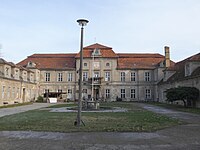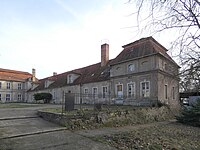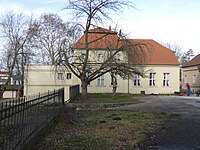Plaue Castle
The Schloss Plaue is a baroque palace complex in about Brandenburg belonging to city and district Plaue . It is located on the west bank of the Havel, directly at the outflow from the Plauer See . It was built on the remains of Plaue Castle. The Schlosspark Plaue as a landscape garden extends south of the castle on the banks of the Plauer See up to the Wendsee .
history
Prehistory
In place of the castle there was probably already a Slavic rampart , which is only indirectly proven. Several sherds from the 9th to the 12th century that are of Slavic origin were found during earthworks . The area is also typical for a Slavic castle wall (see castle wall Parey , Pilatsch (castle wall) or castle wall "Alt Rathenow" ) directly on the bank of the Havel about 2 meters above the surrounding level .
Border fortress between Brandenburg and Magdeburg
Between the 12th and 15th centuries, the strategically important Plaue was disputed as a ferry location on a trade route that was already important in the Middle Ages , today's Bundesstraße 1 , and the Havel between the Mark Brandenburg and the Archbishopric of Magdeburg . The castle has long secured the border between the territories . Plaue was first mentioned in 1197 as the name of a family that named itself or was named after the castle. Several members of the family were bound as ministerials to the Archbishop of Magdeburg or the Bishop of Brandenburg . Heinrich de Plawe , mentioned in 1197 and 1198, was committed to the latter .
The place Plaue itself was first mentioned in 1216 as the main border place between the Diocese of Brandenburg and the Archdiocese of Magdeburg , which should not be confused with the secular territories of the Mark and the Archbishopric. Before 1268, Plaue and its castle were owned by the Margrave of Brandenburg , but then apparently came to the ore monastery of Magdeburg after the Ascanian line of rule died out. In 1294 the castrum Plaue was mentioned in writing. From 1334 the castle ( hus ) was pledged along with the right of escort and customs law . In some cases, the pledge was tied to the condition that the castle be structurally improved. On the east bank, the Brandenburg margraves built a counter castle , which was mentioned in 1336 as Niederhus . In Magdeburg's oldest feudal books , the castrum Plaue was described as the seat of archbishop's castle men and vassals , who had their fiefs in the surrounding Magdeburg villages .
Robber baron castle
Because of disputes between Brandenburg and Magdeburg, which also repeated martial had been fought, it came in the late 14th century in a relatively independent rule of the mortgage holder of the castle Plaue. This initially applied to Lippold von Bredow , governor of the Mittelmark . His daughter Agnes was married to Johann von Quitzow , so that the castle passed to him. Johann von Quitzow had achieved a completely independent position on Plaue and for many years together with his brother Dietrich von Quitzow, as a robber baron, he made Brandenburg and Magdeburg possessions unsafe. In 1414, Margrave Friedrich I, in alliance with the Archbishop of Magdeburg, took the castle after the siege and drove the Quitzows out of Plaue. In 1421, the disputes between Brandenburg and Magdeburg over Plaue Castle were settled on the basis of an arbitration award and the waiver by Archbishop Günther II . Archbishop Friedrich III. finally renounced Plaue in a treaty of Zinna in 1449 .
In the Electorate of Brandenburg until it was destroyed in the Thirty Years War
In 1459, the electoral chamber master Georg von Waldenfels received Plaue with the condition that he should have a bridge built in 1463 instead of the ferry connection over the Havel. In 1469 a hereditary fiefdom was tied to the condition of renewing the fortifications of the castle. A castle chapel with an Anne altar was described for the first time in the early 16th century . Elector Joachim I took Plaue personally in 1531. In 1544 it was given back to Franz von Dornstätt for 12,000 guilders . To compensate him, Matthias von Saldern , husband of Gertrud von Saldern , advanced 5,000 guilders to the Elector and in turn received Plaue Castle as a pledge, although in 1547 this had been committed to Sabina von Brandenburg-Ansbach , the wife of the future Elector Johann Georg , for private property. In 1560, Elector Joachim II Matthias von Saldern exchanged the pledge for the Plattenburg . In 1577 Johann Georg sold Plaue Castle to the von Arnim family . During the Thirty Years' War the castle and the small town of Plaue were destroyed.
From thirty to the Second World War
Plaue Castle had been in the possession of the von Görne family since 1620 . The Prussian minister Friedrich von Görne had the Plaue Palace built in its still existing form from 1711 to 1715 or 1716 as a new baroque building. The new building is said to have cost 23,460 thalers . He remained lord of the castle until 1745. His successor was his son Leopold von Görne from 1745 to 1765 , who sold the castle. He was succeeded as castle owner from 1765 to 1793 by the Prussian general Heinrich Wilhelm von Anhalt , who had many of the structures created in Plaue dismantled, and the family of Adolf Julius Freiherr Lauer von Münchhofen and his wife Marie Magdalene Charlotte Baroness von Stoltzenberg , the former mistress and second Wife of Margrave Friedrich Heinrich von Brandenburg-Schwedt . In 1839 Plaue Castle came to the Counts of Königsmarck , who owned it until 1945.
From 1945
At the end of the Second World War , Plaue Castle was looted by the Red Army . After the expropriation , it became a rest home for Soviet children and a military hospital for a short time . An administration school was housed from 1946 to 1966 . Between 1965 and 1966, a repair was carried out , as a result of which the facade was greatly simplified. Then an institute for intensive language training, an interpreting school of the Ministry of Foreign Affairs of the GDR , moved in.
In 1989 the building was opened to the public for the first time. In 1993 the language institute was closed and the Plaue Palace became the property of the State of Brandenburg .
architecture
Plaue Castle is a three-wing castle complex. The eastern corps de logis stands directly on the Havel and has two floors. The central projection is raised by a mezzanine . The mansard roof is covered with red beaver tails . For example, tail dormers can be found as clear openings . On the upper floor there is a balcony in the middle of the main courtyard and the river . A two-part flight of steps on the river side has been largely dismantled. The side wings are single-storey. The southern side wing ends with the former castle chapel, which has also been raised by a mezzanine. The former castle chapel has a mansard roof, the rest of the southern wing has a gable roof with hipped dormers. The northern side wing has a roof with a crooked hip and hipped dormers. The facade of the castle is plastered in gray. Structuring elements include cornices , window surrounds , from stucco decorated keystones . Structurally separated from the north wing by a path there is a head building built in 1913, which surrounds the courtyard. This has a mansard roof. There is a fountain in the courtyard .
Castle Park
The palace park is located south of the palace. It extends along the north-western bank of the Plauer See to the Wendsee or the Seegartenbrücke . Its expansion is the result of an expansion by Leopold von Görnes in 1755 and the transformation into a landscape park under the von Königsmarck family around 1850. The castle park has been accessible to the population since 1935. The Plauer Fontaneweg , the Havel cycle path , the Brandenburg tour and the 7-lake tour lead through the castle park.
In the English landscape garden there are remains of old buildings. The so-called Hunger Tower was a staffage building with lines of sight to the castle and the lake. This was removed to its foundation in the 1950s. The base of an urn statue on which the dogs of the Counts of Königsmarck were buried is also preserved. On the site of a former horse grave, there has been a bronze sculpture by Theodor Fontane since 2012 , who made Plaue Castle the subject of his story in 1889 in the fifth volume Five Castles of his work Walks through the Mark Brandenburg . The sculpture was created by the artist Dirk Harms .
A clay pigeon shooting range is said to have been the world's oldest preserved and built around 1900 by the castle owner Hans Adolf Erwein Max Graf von Koenigsmarck. It is decorated with larger-than-life animal figures, a bear and a Markhor ( Capra falconeri ), memories of a hunting trip in the Himalayas and trophies that were added later. The shooting range was restored in 2013 and the heavily damaged animal figures were replaced by duplicates .
The castle pond south of the castle has two connections to the Plauer See, over which two arched, curved bridges made of bricks run between 1851 and 1880 . The parish garden wall is also made of bricks. This is the rest of the former boundary wall and comes from the early phase of the landscape park, around the middle of the 19th century. The cemetery wall was built at the same time as the parish garden wall . From the castle park you can reach the cemetery of the Plaue parish church through the so-called Engelstor . Through this gate, the patron family had their own access from the castle to the cemetery with its family graves and to the church. The iron angel gate is framed by two large angel sculptures on plinths. The angels were made from sandstone by A. Möller in 1835 on behalf of the lady of the castle, Baroness Charlotte von Lauer-Münchhofen .
A landing stage projecting into the Plauer See in a T-shape was used by the customs administration of the GDR . It was used to monitor inland shipping to and from West Berlin . The pier was raised in the mid-1970s and was provided with a guard house and barrier .
In the south of the park there is a former brick factory . The brickworks operated from at least 1842 to 1914. It initially belonged to a Ferdinand Michaelis from the city of Rathenow and was later taken over by the Count of Koenigsmarck. After the closure, a tree nursery and market garden were operated on the site , which were cultivated until the early 1990s. The management of the park was already housed in buildings of the brickworks from around 1890. The coach house was there.
A pond in the southwest of the park in which crucian carp ( Carassius carassius ), a type of carp fish, was bred, has silted up . This part of the park is poorly maintained and left overgrown as a retreat for birds and other animals. There is also a school building and a sports field adjacent to former parking areas. A French garden was surrounded by a wall about 2 meters high. For example, fruit was grown in this palace garden . It was destroyed after the expropriation in 1945. Remnants of the wall on the private property bordering the castle park have been preserved.
Web links
Romanesque routes in Berlin and Brandenburg - Plaue Castle and Church
literature
- Theodor Fontane : Walks through the Mark Brandenburg . Volume 5: Five locks . Chapter: Plaue a. H. Pages 64 to 91
- Sebastian children, Haik Thomas Porada on behalf of the Leibniz Institute for Regional Geography and Saxon Academy of Sciences in Leipzig (ed.): Brandenburg an der Havel and surroundings. A geographical inventory in the area of Brandenburg an der Havel, Pritzerbe, Reckahn and Wusterwitz (= Landscapes in Germany. Values of the German homeland . Volume 69 ). Böhlau Verlag, Cologne 2006, ISBN 3-412-09103-0 , p. 120-128 .
- Adolph Friedrich Riedel (Ed.): Codex diplomaticus Brandenburgensis . Volume 10. Chapter: XXI Castle and town of Plaue . Pages 1 to 35.
- Georg Dehio : Handbook of the German art monuments . Berlin / GDR Potsdam. German art publisher . Munich, Berlin 1983. p. 175. ISBN 3-422-00365-7 .
Individual evidence
- ↑ Hans-Georg Schede: Caroline Schede: A story of private life in the time of Goethe . P. 152, Berliner Wissenschafts-Verlag , 2018 Berlin, ISBN 978-3-8305-3754-0
- ^ Sebastian children, Haik Thomas Porada (ed.): Brandenburg an der Havel and surroundings. 2006, pp. 120 to 128.
- ^ Peter-Michael Hahn, Hellmut Lorenz Nicolai (ed.): Manor houses in Brandenburg and Niederlausitz . Commented new edition of Alexander Duncker's (1857–1883) works of views. 2000. page 454.
- ↑ 7 lakes tour. In: havelland-tourismus.de. Retrieved April 6, 2019 .
- ↑ 1st stage of the Brandenburg tour: Brandenburg an der Havel - Rathenow. In: reiseland-brandenburg.de. Retrieved April 6, 2019 .
- ↑ Description of the castle park. Förderverein Schlosspark Plaue eV, accessed on February 7, 2019 .
Coordinates: 52 ° 24 ′ 28.4 " N , 12 ° 25 ′ 17" E










